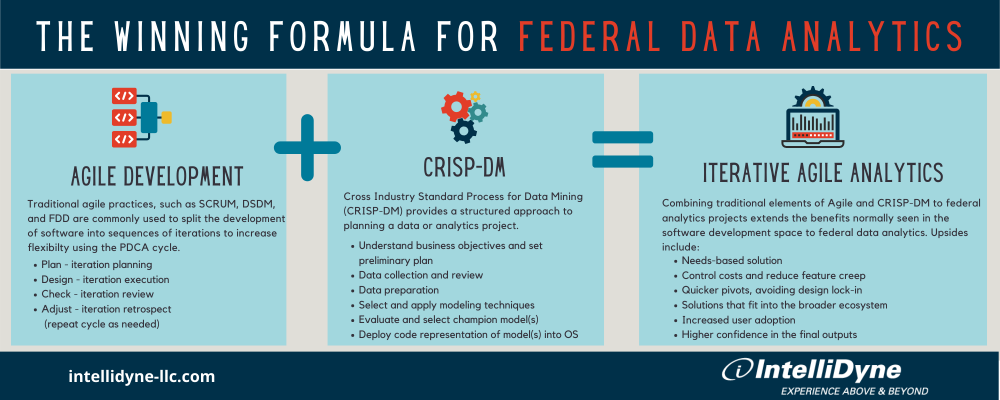By Jenny Glenski and Phil Vincenzes
Software developers know that user involvement drives understanding, buy-in, and adoption, which has been shown to be true in analytics work as well—especially now that embedding analytics into business applications has become commonplace. Analytics projects have evolved from simply delivering libraries of tested algorithms into sophisticated business applications with elegant user interfaces. Thanks to the successful marriage of Agile and the Cross Industry Standard Process for Data Mining (CRISP-DM), the convergence of analytics and business applications can provide a user experience that is just as satisfying as any of the popular software applications.
CRISP-DM has become a standard methodology used in analytics and provides a structured approach to planning a data or analytics project. In recent years, teams have also seen great outcomes from incorporating Agile, a methodology commonly used in software development, into their analytics projects. Adapting an iterative agile design cycle and Agile methodology to fit into CRISP-DM analytics projects has extended the benefits normally seen in the software development world to the analytics space, including:
- Involvement of the users to serve their needs, not the ego of the developer.
- Reduced chance of additional cost and time lost to feature creep.
- Quicker pivots and better ideas resulting from prototyping early—project teams do not feel locked into a design because of work already invested.
- Deeper understanding of users’ business processes, which enables developers to deliver products that fit into the wider, more complex context surrounding the task at hand and reduce the risk of solutions falling short of users’ needs.
- Higher rate of user adoption since stakeholders are involved and can explain and justify approaches to others.
- Better trust in the final solution and sense of control in the process. For example, when users are not exposed to underlying elements of an artificial intelligence (AI) application, they find it more difficult to trust and rely on its outputs.
We have experienced the positive effects of using Agile with CRISP-DM in many situations, and we have witnessed the pitfalls of choosing one methodology over the other. The key is merging Agile with CRISP-DM to get the best of both methodologies. Incorporating user-centered, iterative design cycles by way of Agile in traditional CRISP-DM analytics projects results in more successful outcomes for all involved, from the developers to the users. This Agile Analytics approach has become our standard methodology at IntelliDyne, since we decided to implement a hybrid of data science and software engineering methodologies over 5 years ago. Agile Analytics allows us to deliver data-centric solutions to our clients, and we plan to continually refine it by learning and leveraging from other disciplines as they emerge.
Click the image below to view full size.
Learn More About IntelliDyne’s Analytic Practices:
——————–
Phil Vincenzes
Chief Analytics Officer
Phil Vincenzes is IntelliDyne’s Senior Vice President and Chief Analytics Officer, spearheading initiatives to deliver visually-compelling, knowledge-based solutions using advanced analytics to exploit information and reveal actionable intelligence and insights.



